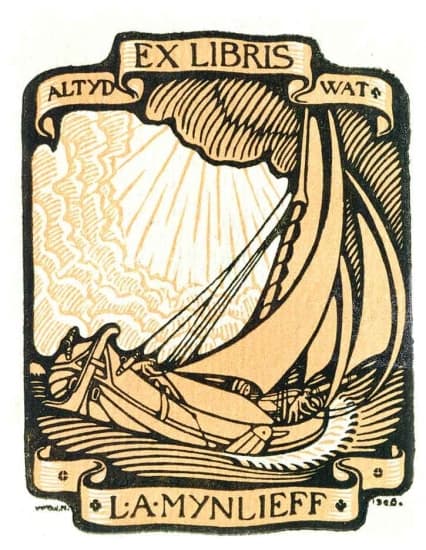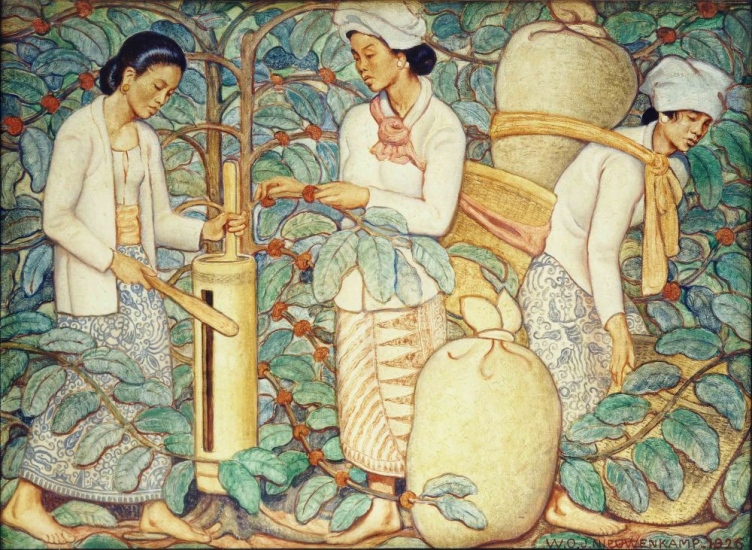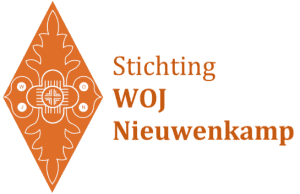"While wandering, I acquire"
Wijnand Otto Jan Nieuwenkamp spent his life travelling and wandering. He drew his inspiration from foreign peoples and tropical nature, but explored the Netherlands thoroughly too. Wandering was in his blood and he followed his own motto: Vagando Acquiro (While wandering, I acquire). Frequently he would be away for months, only to return to his family brim full of impressions of his travels, and loaded with drawings (it is no surprise that he hardly spent any time raising his children).
His journeys to the islands of Java and Bali, parts of the former colonial Netherlands East Indies, in particular, moved him to the depths of his soul, and also moulded his personality.

List of Nieuwenkamp's journeys
- 1894. At the age of twenty Wijnand was far too skinny so, acting on his doctor’s advice he joined a boat heading for the Mediterranean. This first long journey started in August 1894, aboard the steamboat the SS Ceres. The journey took him through Lisbon, Tangier, Gibraltar, Livorno, Catania and then back to the Netherlands. It was on this journey that Nieuwenkamp got his passion for travelling, a passion he never lost….
- In 1898 he went on his first journey to the Netherlands East Indies (the island of Java).
- In 1899 he travelled to Belgium with the graphic artist, gold and silversmith Elias Voet, then journeyed to France and Spain.
- In 1900 he went on honeymoon and crossed Belgium and France to Spain with his wife Anna Wilbrink.
- During the years 1901 and 1902, they sailed around the Dutch canals and lakes on board the De Zwerver, regularly passing through Edam.
- In 1903, the journeys aboard the De Zwerver took them to Germany, including visits to Düsseldorf and Neurenberg and other places.
- From 1903 to 1904 he embarked on a second long journey to the east.
- In the winter of 1906/1907 a third long journey took him to the islands of Java and Bali.
- In the winter of 1908 Nieuwenkamp visited Constantine in Northern Africa. His two drawings are the only remaining records of this journey.
- In 1913/1914 he undertook a long journey to British India, including visits to Ceylon and the British Indies (Tanjore, Benares, Agra, Gwalior, Bombay and Madoera). He created many drawings during this journey and, in 1924, he published his travel report on the British Indies as a book, entitled Holy Cities (Heilige Steden). In addition, a series of articles about his journey were published in the NION, Netherlands East Indies, Now and Before, [Nederlandsch-India, Oud en Nieuw]. By no means all his work has been published in the NION, many pencil sketches and photos (snapshots) that fellow traveller Barlett had given him, have survived. After the publication of Holy Cities he made more etchings and oil paintings and a few gouaches about India, Hinduism and Buddhism. Few of these works have been published.
- Between 1917 and 1919 he embarked on his fourth journey to the Netherlands East Indies.
- In 1920 he travelled from Edam to Sicily to spent the winter and, in 1921, he ended up in Rome, settling near Fiesole, close to Florence, in 1925.
- In 1925 he undertook another long journey to the islands of Sumatra, Java and Bali.
- In 1933-1934 Nieuwenkamp set off on a journey that took him through Egypt, where he made many drawings of the pyramids, Cairo, Luxor and the river Nile. A manuscript exists that has not been published: In the land of the Pharaohs [In het land der Faraos]. He had already visited Egypt in 1904 during a previous journey to the Netherlands East Indies where he had completed a number of drawings.
- His long journey in 1937, funded by several institutions, once again brought him back to Bali.
- In May 1940 he was about to embark on his next long journey, but the outbreak of World war II prevented him from setting off. He never travelled outside Europe again.
Anecdote
Travelling was not always so pleasant, as illustrated by the following episode taken from Journey to Soemba [Een reis naar Soemba], in 1918; Nieuwenkamp was sailing to the island of Timor.
‘In Surabaya our steamboat holds were disinfected. ‘In Surabaya the holds of our steamboat were disinfected. In deadly peril, the rats stayed hidden in the sloops on deck, and countless numbers of cockroaches took sanctuary in the dining hall and first-class cabins. Every night, when I turned back the covers of my bed a dozen or so three inch long loathsome cockroaches would dart away to all sides, and with a slipper as a weapon, I would engage in a lively chase. Every evening we continued the chase, joined by some fellow travellers, and helped by some lads in the dining-hall. We would not go to bed until at least a hundred victims had been squashed on the floor.
Excerpted from: Voyages to Dutch Timor [Zwerftochten naar Timor en Onderhoorigheden]. 1925.

Houseboat De Zwerver
During their honeymoon in 1900, Wijnand discussed his plans about living in a travelling home with Anna. He did not want settle permanently. They decided they would live on the water and so he built them a houseboat, the De Zwerver, a beautiful home, with a studio. For ten years the young family sailed around the waters of Northern Europe, mooring in many places, particularly across the Netherlands, Belgium and Germany. During this time their four children were born: Marianne, Willem, Maria and Fernande (Ferry).
A home of his own design
Nieuwenkamp drew the design for the De Zwerver himself and worked up the design in cooperation with boatyard boss Sjollema. He also helped to build the boat. The boat’s interior resembled, and still does, a classic seventeenth century Amsterdam canal house. From 1902 onward, the boat sailed on canals and lakes. Usually tugs would tow the De Zwerver, but sometimes they used horses to draw the boat, or they would simply pole. Nieuwenkamp set up a studio, including an etching-press, on board, and he and his family started to live on the boat.
Since 2011 the De Zwerver has been back in the possession of the Nieuwenkamp Museum Foundation. Currently the board is examining the options for its future use.
Exhibitions on board
Anyone who ever visited the De Zwerver was amazed by its beautiful interior design. Word of mouth advertising proved to be very effective. The painter Theophile the Bock visited the boat and suggested that Nieuwenkamp hold an exhibition of his art work aboard the boat and charge entrance fees. Initial hesitation ultimately gave way to enthusiasm, and in August 1902 Nieuwenkamp organised his first exhibition on board. To say it simply worked, would be an understatement! There was a run on his works of art! . And so the De Zwerver was converted into a sailing house-cum-art gallery, mooring in lots of different places, so that people could see and buy Nieuwenkamp’s works.

Journeys to the Netherlands East Indies
Nieuwenkamp’s journeys into the Netherlands East Indies, lasting several years, were remarkable, especially those that took him to the island of Bali. Between 1898 and 1938 he embarked on six long journeys to the former Netherlands East Indies, and visited Bali, in particular, where he made several discoveries and wrote a number of books and countless articles. Nieuwenkamp was one of the first people to come to Bali, not for a military or administrative reason but out of pure interest in Balinese art and nature.
Justus Van Maurik encouraged Nieuwenkamp to embark on a journey to the Netherlands East Indies, and lent him the money to pay for the trip. In late December 1897 Nieuwenkamp set off, staying first in Batavia with several families, and then travelling across the island making several illustrations on the way. He was very successful and was able to sell his prints. In August 1898 he got back to Haarlem and had earned so much money by that time that he was able to repay Van Maurik and with the remainder construct his own wooden studio.
The drawings that Nieuwenkamp sent to the Netherlands which were made during his first journey in 1898 were published in the journals he was working for. G.P. Rouffaer, who had been an ethnographer of the highest order, noticed his drawings. Rouffaer, Managing Director of the Ethnographic Museum in Haarlem (later to become the Dutch Tropical Institute), asked Nieuwenkamp to purchase some objects for him, including beautiful objects and native art made by local artists and craftsmen. This permitted Nieuwenkamp to finance part of his second journey. Rouffaer, who had also travelled to the Indies, recommended that Nieuwenkamp visit Bali in particular.
In mid-December 1903 Nieuwenkamp departed, first going to Egypt for a short stay and then travelling on to Singapore, Batavia, Bali and Lombok. In early June 1904, he returned to the Netherlands.
Nieuwenkamp was hugely impressed by Bali
Bali made a strong impression on Nieuwenkamp. He had wandered mainly around the northern part of the island joining the governor on his journey back to Lombok. This is probably where he caught malaria and the reason for him cutting short his journey. He took a lot of drawings and artefacts back to the Netherlands and, deciding that they needed some sort of commentary, he wrote a book about them. Nieuwenkamp had also purchased a lot of objects for himself; objects that would soon form the beginning of his Indian collection, a collection that was to become the largest privately owned Dutch collection of ethnographic works.
In as early as May 1906 Nieuwenkamp travelled back again to the East, largely supported by the government funds, the royal family, the National Ethnographic Museum in Leiden, and many other institutes and private individuals. He wanted to go back to Bali and finish his book Bali and Lombok.
After an initial ban on travelling to Bali (a military expedition to Bali was under way, aiming to bring Bali almost entirely under Dutch rule), Governor General Van Heutsz gave Nieuwenkamp permission to travel to Bali with the army and there he witnessed the conquest of southern Bali. He remained in Bali until the spring and then returned to the Netherlands bringing back with him a large number of sketches and drawings. Nieuwenkamp also shipped chests, loaded with the artefacts he had purchased, to the Netherlands separately. These objects now form the heart of a number of Indian collections owned by several large Dutch Ethnology museums.
Nieuwenkamp made lots of drawings. After returning home, he would format/rework his etchings and drawings, most of which were published together with the ones he made in 1904 in Bali and Lombok, (1910) and Wanderings around Bali (Elsevier, 1910).
Anecdote
Nieuwenkamp had the largest private collection of Asian art in the Netherlands. But finally he gave up on collecting and began to downsize his collection by selling and donating his works.
‘… Then all of a sudden I had enough of expanding the collections, for in this humid town of Edam everything was always getting mouldy and spoiling. And so every year when I was in Holland I would spend days at a time, ventilating, checking, and cleaning all my possessions. Even in Egypt, where I spent the winter of 1933/1934, I was able to resist the temptation to buy something, even though there were so many beautiful things, to be bought for so little money… ‘.
From: My home on the water, my home on the land, continuation, 1931-1935, page 171.
The First World War forced Nieuwenkamp to stay in the Netherlands for a long time. When, in September 1917, a boat finally did set off to the Indies, he made sure he was on board. This time the trip around the world lasted one and a half years. Because of the war in Europe the route took him through the Panama Canal, via San Francisco, Japan, Hong Kong, Canton and finally to Batavia. Many institutes funded Nieuwenkamp with generous financial resources. And, in part thanks to his book, he was held in great esteem in scientific circles, as a well-respected researcher. He was also commissioned to carry out certain studies and to purchase a number of objects.
On board he became seriously ill, suffering from malaria, various infections and Spanish influenza. In Batavia, he stayed in the Hotel der Nederlanden and managed to book a passage to the Netherlands on board the SS Noordam. On the final page of his travel notes from 1917 to 1919, he wrote:
And there was this famous explorer, very thin and very pale, sitting in the large dining room of the Hotel der Nederlanden, tucked away in a corner out of the draughts, hiding behind a table, unenthusiastically eating his rice pudding.’
Once on board he slowly recovered. He returned home in late January 1919.
He described part of this journey in Wanderings around Dutch Timor, published in 1925. Everything he wrote about this journey is contained in two files, and in the notes from his notebook and diary. Although they were never published, many of these documents are of great cultural and ethnographic interest. After his return, he reworked his writings about his visit to Bali, publishing them in a revised edition of Wanderings around Bali (1922).
In March 1925, Nieuwenkamp, now living in Italy, travelled to Sumatra and Java, to fulfil a major art commission given to him by the Handels Vereeniging Amsterdam (HVA). To do this he visited the society’s companies, availing himself of an opportunity to travel to Bali, where he remained until July. Again criss-crossing the island, he completed lots of drawings and made some major discoveries.
In August he returned to the Netherlands and held a big clearance sale in his studio in Edam, and on 12 September 1925 a major exhibition of his works opened at the Stedelijk Museum in Amsterdam.
Based on this fifth trip, the Museum Nieuwenkamp Foundation has created a manuscript, ready for publication, containing all the drawings that have not been published as a book to date.
By the end of 1936, Nieuwenkamp, aged over 60 now, travelled to Java and Bali for the last time. The Adult Education Centre in Rotterdam had asked him to purchase some artefacts and create a Balinese calendar. He was given free passage to Batavia aboard the SS Kota Nopan owned by the Rotterdam Company Lloyd.
On arrival, he made a study of the Borobudur and the surrounding area and explored Bali once again. This time the journey was mostly done by car. On Bali he met many friends and celebrities, like Tjokorda Sukawati, Walter Spies, Beryl the Zoete and his friend and painter Rudolf Bonnet whom he travelled around with. He returned home in May 1937.
After his return he worked predominantly on his books and paintings. In the winter of 1937 the Adult Education Centre in Rotterdam held a huge Balinese Christmas exhibition where the artefacts that Nieuwenkamp had purchased on Bali and a number of his lithographs and etchings were sold.
Two handwritten manuscripts, describing this journey, have survived, the last one dating from around 1945. They contain a lot of sections of text because many of the drawings had not been published before.
